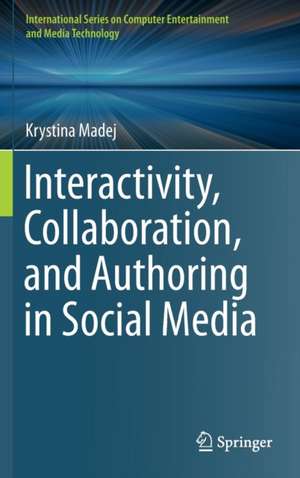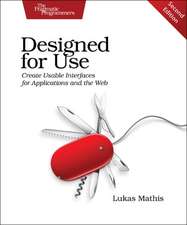Interactivity, Collaboration, and Authoring in Social Media: International Series on Computer, Entertainment and Media Technology
Autor Krystina Madejen Limba Engleză Hardback – 29 ian 2016
At the forefront of narrative innovation are social media channels – speculative spaces for creating and experiencing stories that are interactive and collaborative. Media, however, is only the access point to the expressiveness of narrative content. Wikis, messaging, mash-ups, and social media (Facebook, Twitter, YouTube and others) are on a trajectory of participatory story creation that goes back many centuries. These forms offer authors ways to create narrative meaning that reflects our current media culture, as the harlequinade reflected the culture of the 18th century, and as the volvelle reflected that of the 13th century.
Interactivity, Collaboration, and Authoring in Social Media first prospects the last millennium for antecedents of today’s authoring practices. It does so with a view to considering how today’s digital manifestations are a continuation, perhaps a reiteration, perhaps a novel pioneering, of humans’ abiding interest in interactive narrative. The book then takes the reader inside the process of creating a collaborative, interactive narrative in today’s social media through an authoring experience undertaken by a group of graduate students. The engaging mix of blogs, emails, personal diaries
, and fabricated documents used to create the narrative demonstrates that a social media environment can facilitate a meaningful and productive collaborative authorial experience and result in an abundance of networked, personally expressive, and visually and textually referential content. The resulting narrative, After Love Comes Destruction, based in Shakespeare’s Romeo and Juliet, shows how a generative narrative space evolved around the students’ use of social media in ways they had not previously considered both for authoring and for delivery of their final narrative artifact.
| Toate formatele și edițiile | Preț | Express |
|---|---|---|
| Paperback (1) | 326.64 lei 6-8 săpt. | |
| Springer International Publishing – 30 mar 2018 | 326.64 lei 6-8 săpt. | |
| Hardback (1) | 332.89 lei 6-8 săpt. | |
| Springer International Publishing – 29 ian 2016 | 332.89 lei 6-8 săpt. |
Preț: 332.89 lei
Preț vechi: 416.12 lei
-20% Nou
Puncte Express: 499
Preț estimativ în valută:
63.71€ • 66.26$ • 52.59£
63.71€ • 66.26$ • 52.59£
Carte tipărită la comandă
Livrare economică 14-28 aprilie
Preluare comenzi: 021 569.72.76
Specificații
ISBN-13: 9783319259505
ISBN-10: 3319259504
Pagini: 161
Ilustrații: XVII, 161 p. 84 illus., 67 illus. in color.
Dimensiuni: 155 x 235 x 16 mm
Greutate: 0.43 kg
Ediția:1st ed. 2016
Editura: Springer International Publishing
Colecția Springer
Seria International Series on Computer, Entertainment and Media Technology
Locul publicării:Cham, Switzerland
ISBN-10: 3319259504
Pagini: 161
Ilustrații: XVII, 161 p. 84 illus., 67 illus. in color.
Dimensiuni: 155 x 235 x 16 mm
Greutate: 0.43 kg
Ediția:1st ed. 2016
Editura: Springer International Publishing
Colecția Springer
Seria International Series on Computer, Entertainment and Media Technology
Locul publicării:Cham, Switzerland
Public țintă
ResearchCuprins
Introduction.- Print Narrative, Interactivity, and Collaboration.- Narrative as Material Practice – a Digital Domain.- Storytelling on the Web: Collaborative Authoring and Social Media.- Romeo and Juliet on Facebook: After Love Comes Destruction.- Collaborative Authoring in a Social Media World.
Notă biografică
Krystina Madej is Visiting Professor at the School of Literature, Media, and Communication at Georgia Tech in Atlanta and at the Center for Digital Media in Vancouver, Canada. She is co-author of Disney Stories: Getting to Digital with Newton Lee (Springer 2012).
Textul de pe ultima copertă
This book includes a short history of interactive narrative and an account of a small group collaboratively authored social media narrative: Romeo and Juliet on Facebook: After Love Comes Destruction.
At the forefront of narrative innovation are social media channels – speculative spaces for creating and experiencing stories that are interactive and collaborative. Media, however, is only the access point to the expressiveness of narrative content. Wikis, messaging, mash-ups, and social media (Facebook, Twitter, YouTube and others) are on a trajectory of participatory story creation that goes back many centuries. These forms offer authors ways to create narrative meaning that reflects our current media culture, as the harlequinade reflected the culture of the 18th century, and as the volvelle reflected that of the 13th century.
Interactivity, Collaboration, and Authoring in Social Media first prospects the last millennium for antecedents of today’s authoringpractices. It does so with a view to considering how today’s digital manifestations are a continuation, perhaps a reiteration, perhaps a novel pioneering, of humans’ abiding interest in interactive narrative. The book then takes the reader inside the process of creating a collaborative, interactive narrative in today’s social media through an authoring experience undertaken by a group of graduate
students. The engaging mix of blogs, emails, personal diaries, and fabricated documents used to create the narrative demonstrates that a social media environment can facilitate a meaningful and productive collaborative authorial experience and result in an abundance of networked, personally expressive, and visually and textually referential content. The resulting narrative, After Love Comes Destruction, based in Shakespeare’s Romeo and Juliet, shows how a generative narrative space evolved around the students’ use of social media in ways they had not previously considered both for authoring and for delivery of their final narrative artifact.
About the Author:
Krystina Madej is Visiting Professor at the School of Literature, Media, and Communication at Georgia Tech in Atlanta and at the Center for Digital Media in Vancouver, Canada. She is co-author of Disney Stories: Getting to Digital with Newton Lee (Springer 2012).
At the forefront of narrative innovation are social media channels – speculative spaces for creating and experiencing stories that are interactive and collaborative. Media, however, is only the access point to the expressiveness of narrative content. Wikis, messaging, mash-ups, and social media (Facebook, Twitter, YouTube and others) are on a trajectory of participatory story creation that goes back many centuries. These forms offer authors ways to create narrative meaning that reflects our current media culture, as the harlequinade reflected the culture of the 18th century, and as the volvelle reflected that of the 13th century.
Interactivity, Collaboration, and Authoring in Social Media first prospects the last millennium for antecedents of today’s authoringpractices. It does so with a view to considering how today’s digital manifestations are a continuation, perhaps a reiteration, perhaps a novel pioneering, of humans’ abiding interest in interactive narrative. The book then takes the reader inside the process of creating a collaborative, interactive narrative in today’s social media through an authoring experience undertaken by a group of graduate
students. The engaging mix of blogs, emails, personal diaries, and fabricated documents used to create the narrative demonstrates that a social media environment can facilitate a meaningful and productive collaborative authorial experience and result in an abundance of networked, personally expressive, and visually and textually referential content. The resulting narrative, After Love Comes Destruction, based in Shakespeare’s Romeo and Juliet, shows how a generative narrative space evolved around the students’ use of social media in ways they had not previously considered both for authoring and for delivery of their final narrative artifact.
About the Author:
Krystina Madej is Visiting Professor at the School of Literature, Media, and Communication at Georgia Tech in Atlanta and at the Center for Digital Media in Vancouver, Canada. She is co-author of Disney Stories: Getting to Digital with Newton Lee (Springer 2012).
Caracteristici
Provides history of interactive narratives over almost 1000 years and focuses on collaboration as well as interactivity Shows historical trajectory of interactive narrative against which to consider today’s interactive narratives Provides images of interactive narratives from to Ars Magna to Califia to Inanimate Alice Offers an intimate view of how a small group of authors used social media and brought a canonical work into today’s mashup narrative world Introduces instructors to how their students can collaborate using social media to create a social media narrative Includes supplementary material: sn.pub/extras






















